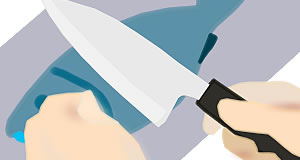What to know before buying a Hocho - Japanese Cooking Knives

Have you ever tried to make Sushi and failed in cutting the fish with a Hocho 包丁, Japanese cooking knife? If someone asked me so, my answer is Yes. What a shame my sushi making ended up making minced fish balls. It is surely not so easy to filet a fish in pieces without a skill. Besides, the choice of what types of knives to use is crucial.
There are several types of Hocho knives, equipped depending on the purpose of use, to cut veges, fish etc.
For cutting fishes, there are two types of Japanese cooking knives, Deba-bocho 出刃包丁 and Sashimi-bocho 刺身包丁, defined as traditional Japanese cooking knives (= Wabocho 和包丁). Deba-bocho is used to clean fish and chop them in pieces, it enables you to file the fish along the backbone finely. Sashimi-bocho is for making Sashimi or Sushi, allows to slice filet shapely with a gentle touch. These knives are essential for professionals working at Japanese restaurants.
Traditional Japanese cooking knives are right-handed.
Another feature of traditional Japanese cooking knives is that they are right-handed, the same as Samurai swords. These traditional cooking knives for left-handed are hard to come by.
The all-purpose knife “Santoku-bocho” is handy.
For use at home, it is not always necessary to provide all types of knives as long as you don’t often make specific dishes, Sushi or Sashimi. Instead, having just one all-purpose knife "Santoku-bocho 三徳包丁" will do. The Santoku-bocho, a type of western-style Hocho (= Youboucho 洋包丁), is most commonly used at home in Japan and often sold at home improvement center and even at supermarkets. There are basically for both right/left-handed.
Steel Hocho vs Stainless Steel Hocho
The advantage of steel-made Hocho knife is that it is solid and durable and excellent in sharpness compared to stainless steel Hocho. On the other hand, steel-made Hocho rust so easily that care should be taken to keep it dry. This is why chefs at Sushi restaurants frequently wipe their Hocho with a towel. Stainless-steel Hocho is much more easily taken care of, and all you have to do is just clean and wipe off the water once after cooking.
How to maintain the sharpness of your home-use Hocho knives
Even a super quality, authentic Hocho knife can easily be as dull as a cheap one if sharpening is not done properly. Though you can buy a whetstone (Toishi 砥石) and try sharpening your Hocho by yourself, it may actually be more "challenging” than you expect. Many people fail in proper sharpening and spoil their Hocho in a short time (like I did.)
To keep and improve the sharpness of your Hocho, it is better to ask at a Hocho shop for their help. The sharpening fee will be somewhere between 600 JP Yen and 1500 JP Yen. If you are a chef working at a Japanese restaurant, you must be skilled in sharpening Hocho knives with a whetstone all by yourself. For home users, using a knife sharpener for daily care will help your Hocho last sharp long. Just rub the cutting edge with the sharpener for a few times before using that will dramatically make a difference in the life span of your Hocho. If you don’t have a sharpener, you can substitute a teacup for whetstone; Just slide the edge aside a few times at the bottom of the teacup.

